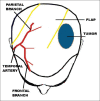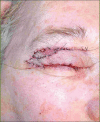Adnexal carcinomas of the head and neck
- PMID: 19753272
- PMCID: PMC2740523
- DOI: 10.4103/0970-0358.44950
Adnexal carcinomas of the head and neck
Abstract
Adnexal carcinomas of the skin are rare and they derive from structures such as sweat glands, sebaceous glands, and hair follicles. Adnexal tumors represent 1-2% of skin cancers. Between 1998 and 2004, eight patients with malignant adnexal tumors of the head and neck were treated in the Plastic Surgery Service in Argerich Hospital in Buenos Aires, Argentina. Four (50%) of them had malignant cylindromas, two (25%) had sebaceous carcinoma, and the other two (25%) syringoid eccrine carcinoma. Tumor resection and local flaps were made in all cases. In one case, a radical neck dissection with superficial parotidectomy was performed to treat the metastatic cervical nodes. Local recurrence observed in two cases (25%) was associated with distant metastasis and death of the patients. In other six cases, the survival rate was 75% after five years.
Keywords: Adnexal carcinomas; adnexal tumors; skin cancer.
Conflict of interest statement
Figures











References
-
- McKee Ph, Mariden R, Santacruz D. Tumors of the epithelial appendages. In: McKee Ph, Mariden R, Santacruz D., editors. London: Mosby Wolfe; 1996. pp. 151–7.
-
- Weedon D. Tumors of cutaneous appendage. In: Weedon D, editor. Skin pathology. London: Churchill Livingston; 1997. pp. 713–58.
-
- Moulin G, Balme B, Thomas L. Encycl. Med. Chir. Paris: Elsevier, Dermatologie; 1996. Tumeurs bènignes de l'épiderme.
-
- Santacruz D. Farmer E, Hood A. Pathology of the skin. London: Appleton Lange; 1990. Tumors of sweat gland differentiation; pp. 624–66.
-
- Grabb W, Smith J. Br J Plast Surg. 1990;43:702–5. Cirugía Plástica. Tercera edición. 1992. p. 534. Inwin L, Bainbridge L, Reid C. Department of plastic and reconstructive surgery, Royal Victoria Infirmary, Newcastle. Dermal Ecrine Cylindroma (Turban Tumour) - PubMed
LinkOut - more resources
Full Text Sources

